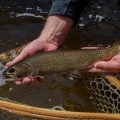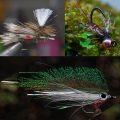“One Rod to Rule Them All”
Most expert fly fishers will tell you that your gear is not that important. You don’t need the world’s best fly rod to catch trout. Nor do you need a killer reel, or the latest waders, or a cutting-edge fly line to be successful on the water. Your skills as an angler and a fly caster are far, far more important than which brand of fly rod you choose, or which model you prefer.
At the same time, though, most of us are at least a little ‘rod-curious.’ I run a small fly fishing school for a couple weeks out of the year and I can’t help but wonder what our School of Trout instructors — who also happen to be some of the finest anglers on the planet — prefer to fish when they’re out on the water. So I asked if they’d be willing to share their favorite all-around fly rod for trout. Here’s what they told me.
Craig Mathews, internationally-acclaimed angler, author, fly designer, and founder of Blue Ribbon Flies in West Yellowstone, Montana: “I fish a Tom Morgan Rodsmiths 8’6” 5 weight graphite most of the year. It’s a most efficient casting tool, and since I like to fish dry flies most of the time, the slow action protects the fine tippets I use.”
Kirk Deeter, author, fly fishing guru and editor of TROUT magazine: “New Scott Centric 9’ 5 weight.”
Tom Rosenbauer, author, angling expert, and perhaps the most respected fly fisher on the planet: “9’ 4 weight.”
Jeff Currier, internationally-recognized fly fishing savant, author, and artist: “Technical small dry fly fishing is my favorite fishing of all and hands down I like a 9’ 4 weight. But, you can’t always count on small dry fly fishing. Some days require nymphing or streamer fishing and a 4 weight is too light. Therefore, for me, my best all-around rod for trout fishing is a 9’ 5 weight Winston Pure.”
Hilary Hutcheson, owner of Lary’s Fly & Supply fly shop, fly fishing ambassador, guide, and longtime host of Trout TV: “Orvis H3F 9’ 5 weight.”
Tim Romano, professional photographer, angling rock star, and managing editor of Angling Trade magazine: “My favorite? Not cheap but worth every penny. My Scott 9’ 5 weight Radian is probably my favorite trout rod of all time. It’s magic.”
Pat McCabe, expert angler & fly caster, former guide, fly fishing instructor: “My favorite all- around trout rod is the Winston 3 piece 9’ 5 weight IM6. It’s an older rod that came out in the late 80’s or early 90’s. I’d describe it as a moderate action rod with a relatively progressive taper that loads all the way through to my hand. It’s a versatile rod that’s delicate enough to cast small dry flies with fine tippets (my favorite style of fishing) as well as powerful enough to cast a streamer or heavy nymph when needed. The moderate action allows me to open the loop if I have to fish an indicator with a weighted fly. The responsive tip and mid-section are excellent for mending the line on the water without moving the fly or creating drag. I’d choose the 4 weight version of this rod for dry fly fishing, but the 5 weight is my top pick for a rod that does everything.”
Bob White, member of the Freshwater Fishing Hall of Fame, artist, author, and former recipient of Fly Rod & Reel magazine’s “Guide of the Year” honors: “Fly rods have come so far in the past couple of decades. While they’re difficult to fly with, some of the old two-piece graphite rods still remain my favorites. If I’m driving to the river, I’ll have a two-piece 10’ 4 weight Scott or an old 9’ 5 weight Orvis Western Series in the back of the truck.”
Steve “Mac” McFarland, longtime fly fishing guide and professional instructor: “Scott 3 piece 8’8” 4 weight or 6 weight G series. depending on which river and what I anticipate
fishing with, ie: nymphs with lead, streamers, shorter casts or longer casts, dry flies, big river or small river, is it gonna be windy?”
John Juracek, angling guru, fly casting instructor, author and fly designer: “For me, a fly rod is first and foremost a tool. (That doesn’t preclude it being beautiful and aesthetically pleasing.) As a tool, I ask merely that the rod serve all the requirements of the kind of fishing I’m doing at the time. Since different kinds of fishing call for different rods, I simply can’t pick one “favorite.” How about two instead? My first is a mid-1970s Leonard Golden Shadow, 9’ 6 weight. The main quality of this early graphite rod—typical for many of the era—is that the rod’s very smooth action extends well into the butt, making for an easy-casting rod that communicates well with the hand and arm. I generally use a 5 weight line on this rod, but opt for a 6 in windy conditions and/or when I’m fishing big flies. My second choice is a Montana Brothers 9’ 4 weight. (Montana Brothers is a new rod company formed by former fly shop colleagues of mine; they are bringing their rods to market this year.) Their 4 weight is a superb tool for delicate dry fly and nymph fishing, which is how I spend the vast majority of my fishing time. By way of disclosure, I’ve provided a lot of input into the design of this 4 weight rod.”
And there you have it. We learned about Scotts, and Winstons, and a couple of Orvis rods. There was a Tom Morgan Rodsmiths model, and a Leonard Golden Shadow, and even a new Montana Brothers rod.
The majority of the School of Trout instructors chose 5 weights, and most went with a 9’ rod length as well. Oh, and while Tom didn’t specify a manufacture or a particular model, I’m guessing that he probably wouldn’t argue with Hilary’s choice of an Orvis H3F.
Which brings us to the question of the day. Should you run out and buy any of these rods sight unseen? No, you shouldn’t. My advice, for whatever it’s worth, is that when you’re in the market for a new trout rod, take the time to decide exactly what you want that particular rod to accomplish. Ask yourself which flies you’ll cast, and which techniques you’ll employ, and which fisheries you might target. Then come up with a list of potential options and do your best to test drive them all before you make your final choice. Never buy a rod because someone else likes it, or owns it, or tells you that you need it.
Oh, and one last recommendation. If you’re ever lucky enough to find a fly rod that you absolutely love with all your heart and soul, and if you can afford to do so, buy two. Or even three. Many of my favorite rods — for example, the three piece Winston 9’ 5 weight IM6 that Pat mentioned — were discontinued years ago, and there’s simply no way to replace a rod that breaks or fails after the manufacturer stops making it.













